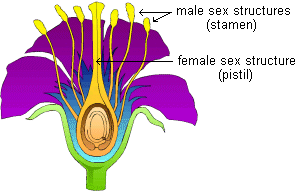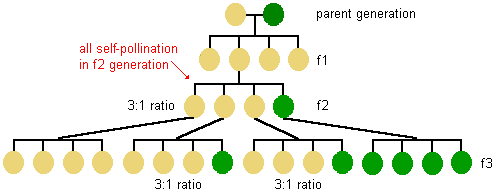The Anthropology Tutorials website will be taken offline on January 9, 2026.
Due to federal accessibility requirements taking effect in 2026, we will be removing this site. If you use materials from this site in your courses or research, please seek alternative resources.
Mendel's
Genetics
|
|
|
 |
Hybridized domesticated horses |
For thousands
of years farmers and herders have been selectively breeding their plants and animals
to produce more useful
hybrids
 . It was somewhat of a hit or miss process since the actual mechanisms governing inheritance were unknown. Knowledge
of these genetic mechanisms finally came as a result of careful laboratory breeding
experiments carried out over the last century and a half.
. It was somewhat of a hit or miss process since the actual mechanisms governing inheritance were unknown. Knowledge
of these genetic mechanisms finally came as a result of careful laboratory breeding
experiments carried out over the last century and a half.
|
 |
|
Gregor Mendel
1822-1884 |
By the
1890's, the invention of better microscopes allowed biologists to discover the basic facts
of cell division and sexual reproduction. The focus of genetics
 research then
shifted to understanding what really happens in the transmission of hereditary traits from
parents to children. A number of hypotheses were suggested to explain heredity, but
Gregor Mendel
research then
shifted to understanding what really happens in the transmission of hereditary traits from
parents to children. A number of hypotheses were suggested to explain heredity, but
Gregor Mendel
 , a little known Central European monk, was the only one who got it more or
less right. His ideas had been published in 1866 but largely went unrecognized
until 1900, which was long after his death. His early adult life was spent in relative obscurity
doing basic genetics research and teaching
high school mathematics, physics, and Greek in Brno (now in the Czech Republic). In
his later years, he became the abbot of his monastery and put aside his
scientific work.
, a little known Central European monk, was the only one who got it more or
less right. His ideas had been published in 1866 but largely went unrecognized
until 1900, which was long after his death. His early adult life was spent in relative obscurity
doing basic genetics research and teaching
high school mathematics, physics, and Greek in Brno (now in the Czech Republic). In
his later years, he became the abbot of his monastery and put aside his
scientific work.
|
|
 |
Common edible peas |
While
Mendel's research was with plants, the basic underlying principles of heredity
 that he discovered also apply to people and other
animals because the mechanisms of heredity are essentially the same for all complex life
forms.
that he discovered also apply to people and other
animals because the mechanisms of heredity are essentially the same for all complex life
forms.
Through the
selective cross-breeding of common pea plants (Pisum sativum) over many generations,
Mendel discovered that certain traits show up in offspring without any blending of
parent characteristics. For instance, the pea flowers are either purple or
white--intermediate colors do not appear in the offspring of cross-pollinated pea plants. Mendel observed
seven traits that are easily recognized and apparently only occur in one of two forms:
|
1. |
flower color is purple or
white |
5. |
seed color is yellow or
green |
|
2. |
flower position is axil or
terminal |
6. |
pod shape is inflated or
constricted |
|
3. |
stem length is long or short |
7. |
pod color is yellow or green |
|
4. |
seed shape is round or
wrinkled |
|
|
This observation that these traits do not show up in offspring plants
with intermediate forms was critically important because the leading theory in biology at
the time was that inherited traits blend from generation to generation.
Most of the leading scientists in the 19th century
accepted this "blending theory." Charles Darwin proposed
another equally wrong theory known as "pangenesis"
 .
This held that hereditary "particles" in our bodies are affected by the things
we do during our lifetime. These modified particles were thought to migrate via
blood to the reproductive cells and subsequently could be inherited by the next
generation. This was essentially a variation of Lamarck's incorrect idea of the
"inheritance of acquired characteristics."
.
This held that hereditary "particles" in our bodies are affected by the things
we do during our lifetime. These modified particles were thought to migrate via
blood to the reproductive cells and subsequently could be inherited by the next
generation. This was essentially a variation of Lamarck's incorrect idea of the
"inheritance of acquired characteristics."
Mendel picked
common garden pea plants for the focus of his research because they can be
grown easily in large numbers and their reproduction can be manipulated. Pea plants have
both male and female reproductive organs. As a result, they can either
self-pollinate themselves or cross-pollinate with another plant. In his experiments,
Mendel was able to selectively cross-pollinate purebred
 plants with particular traits and observe the outcome
over many generations. This was the basis for his conclusions about the nature of
genetic inheritance.
plants with particular traits and observe the outcome
over many generations. This was the basis for his conclusions about the nature of
genetic inheritance.
Reproductive
structures of
flowers |
 |
In
cross-pollinating plants that either produce yellow or green pea seeds
exclusively, Mendel found that the first offspring generation (f1) always
has yellow seeds. However, the
following generation (f2) consistently has a 3:1 ratio of yellow to green.

This 3:1 ratio occurs in later generations as
well. Mendel realized that this underlying regularity was the key to
understanding the basic mechanisms of inheritance.

He came to three important conclusions from
these experimental results:
|
1. |
that the inheritance of
each trait is determined by "units" or "factors" that are passed on to descendents unchanged
(these units are now called genes
 ) ) |
|
2. |
that an individual inherits one
such unit from each parent for each trait |
|
3. |
that a trait may not show up in an
individual but can still be passed on to the next generation. |
It is important to realize that, in this experiment, the
starting parent plants were homozygous
 for
pea seed color. That is to say, they each had two identical forms (or
alleles
for
pea seed color. That is to say, they each had two identical forms (or
alleles
 ) of the
gene for this trait--2 yellows or 2 greens. The plants in the f1 generation were all
heterozygous
) of the
gene for this trait--2 yellows or 2 greens. The plants in the f1 generation were all
heterozygous
 . In other words, they
each had inherited two different alleles--one from each parent plant. It becomes
clearer when we look at the actual genetic makeup, or
genotype
. In other words, they
each had inherited two different alleles--one from each parent plant. It becomes
clearer when we look at the actual genetic makeup, or
genotype
 , of the pea plants instead of only the
phenotype
, of the pea plants instead of only the
phenotype
 , or
observable physical characteristics.
, or
observable physical characteristics.

Note that each of the f1 generation plants (shown
above) inherited a Y allele from one parent and a G allele from the other. When the f1 plants breed, each has
an equal chance of passing on either Y or G alleles to each
offspring.
With all of the
seven pea plant
traits that Mendel examined, one form appeared dominant over the other,
which is to say it masked the presence of the other allele. For example, when the
genotype for pea seed color is YG (heterozygous), the phenotype is
yellow. However, the dominant yellow allele does not alter the
recessive
green one in any way. Both alleles can be passed on to the next generation
unchanged.
Mendel's observations from
these experiments can be summarized in two principles:
|
1. |
the principle of segregation |
|
2. |
the principle of independent
assortment |
According to the
principle of
segregation, for any particular trait, the pair of alleles of each parent separate and
only one allele passes from each parent on to an offspring. Which allele in a
parent's pair of alleles is inherited is a matter of chance. We now know that this
segregation of alleles occurs during the process of sex cell formation
(i.e., meiosis
 ).
).
 |
|
Segregation of
alleles in the production of sex cells |
According to the principle
of independent assortment, different pairs of alleles are passed to offspring
independently of each other. The result is that new combinations of genes present in
neither parent are possible. For example, a pea plant's inheritance of the ability
to produce purple flowers instead of white ones does not make it more likely that it
will
also inherit the ability to produce yellow pea seeds in contrast to green ones. Likewise,
the principle of independent assortment explains why the human inheritance of a particular
eye color does not increase or decrease the likelihood of having 6 fingers on each hand.
Today, we know this is due to the fact that the genes for independently
assorted traits are located on different chromosomes
 .
.
These two principles of
inheritance, along with the understanding of unit
inheritance and dominance, were the
beginnings of our modern science of genetics. However, Mendel did not realize that
there are exceptions to these rules. Some of these exceptions will be explored in
the third section of this tutorial and in the
Synthetic Theory of Evolution
tutorial.
By focusing on Mendel as the father of genetics,
modern biology often forgets that his experimental results also disproved
Lamarck's theory of the inheritance of acquired characteristics described in
the Early Theories
of Evolution tutorial. Mendel rarely gets credit for this because
his work remained essentially unknown until long after Lamarck's ideas were
widely rejected as being improbable.
NOTE:
Some biologists refer to Mendel's "principles" as "laws".
NOTE: One of the reasons that Mendel carried out
his breeding experiments with pea plants was that he could observe inheritance
patterns in up to two generations a year. Geneticists today usually
carry out their breeding experiments with species that reproduce much more
rapidly so that the amount of time and money required is significantly
reduced. Fruit flies and bacteria are commonly used for this purpose
now. Fruit flies reproduce in about 2 weeks from birth, while bacteria,
such as E. coli found in our digestive systems, reproduce in only 3-5 hours.
Copyright 1997-2013 by Dennis
O'Neil.
All rights reserved.
illustration credits
Russian translation

![]() . It was somewhat of a hit or miss process since the actual mechanisms governing inheritance were unknown. Knowledge
of these genetic mechanisms finally came as a result of careful laboratory breeding
experiments carried out over the last century and a half.
. It was somewhat of a hit or miss process since the actual mechanisms governing inheritance were unknown. Knowledge
of these genetic mechanisms finally came as a result of careful laboratory breeding
experiments carried out over the last century and a half.![]() research then
shifted to understanding what really happens in the transmission of hereditary traits from
parents to children. A number of hypotheses were suggested to explain heredity, but
Gregor Mendel
research then
shifted to understanding what really happens in the transmission of hereditary traits from
parents to children. A number of hypotheses were suggested to explain heredity, but
Gregor Mendel
![]() , a little known Central European monk, was the only one who got it more or
less right. His ideas had been published in 1866 but largely went unrecognized
until 1900, which was long after his death. His early adult life was spent in relative obscurity
doing basic genetics research and teaching
high school mathematics, physics, and Greek in Brno (now in the Czech Republic). In
his later years, he became the abbot of his monastery and put aside his
scientific work.
, a little known Central European monk, was the only one who got it more or
less right. His ideas had been published in 1866 but largely went unrecognized
until 1900, which was long after his death. His early adult life was spent in relative obscurity
doing basic genetics research and teaching
high school mathematics, physics, and Greek in Brno (now in the Czech Republic). In
his later years, he became the abbot of his monastery and put aside his
scientific work.
![]() that he discovered also apply to people and other
animals because the mechanisms of heredity are essentially the same for all complex life
forms.
that he discovered also apply to people and other
animals because the mechanisms of heredity are essentially the same for all complex life
forms.![]() .
This held that hereditary "particles" in our bodies are affected by the things
we do during our lifetime. These modified particles were thought to migrate via
blood to the reproductive cells and subsequently could be inherited by the next
generation. This was essentially a variation of Lamarck's incorrect idea of the
"inheritance of acquired characteristics."
.
This held that hereditary "particles" in our bodies are affected by the things
we do during our lifetime. These modified particles were thought to migrate via
blood to the reproductive cells and subsequently could be inherited by the next
generation. This was essentially a variation of Lamarck's incorrect idea of the
"inheritance of acquired characteristics."![]() plants with particular traits and observe the outcome
over many generations. This was the basis for his conclusions about the nature of
genetic inheritance.
plants with particular traits and observe the outcome
over many generations. This was the basis for his conclusions about the nature of
genetic inheritance.




